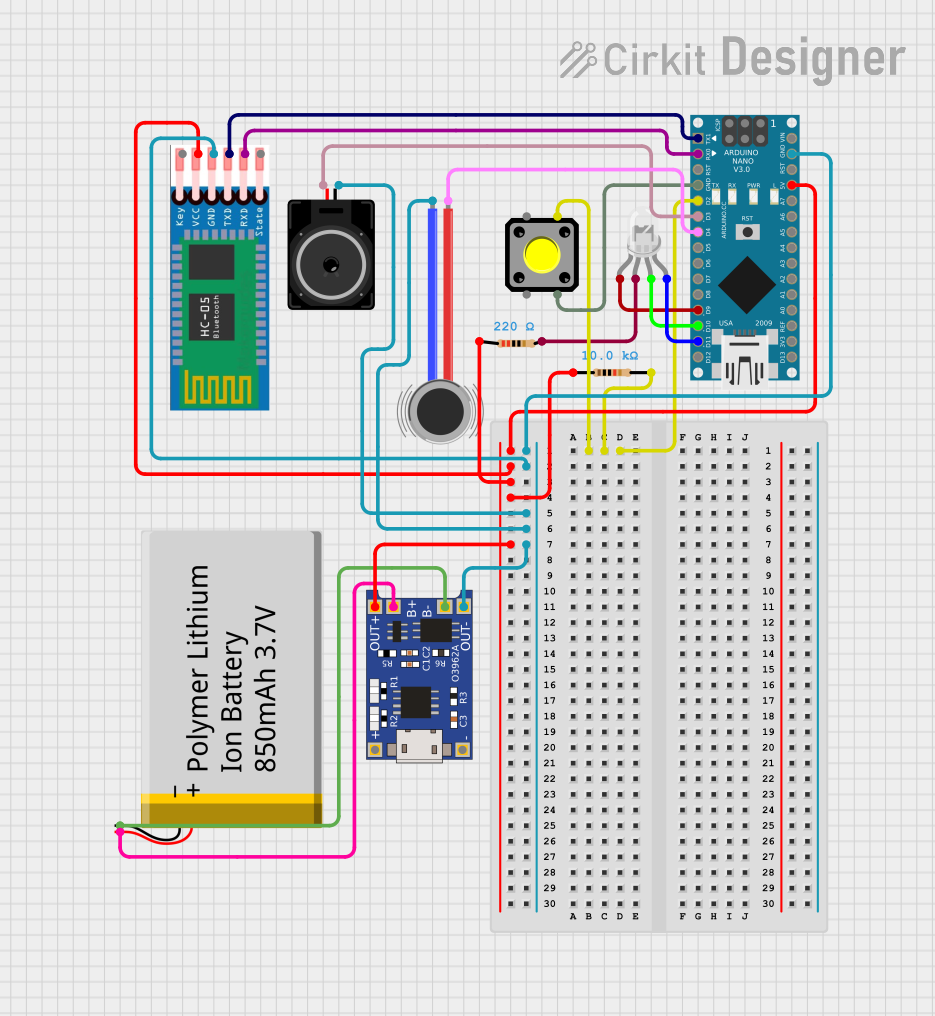
Cirkit Designer
Your all-in-one circuit design IDE
Home /
Project Documentation
Bluetooth-Controlled Multi-Function Arduino Nano Gadget

Circuit Documentation
Summary
This document provides a detailed overview of a circuit that includes various components such as LEDs, a loudspeaker, a vibration motor, an Arduino Nano microcontroller, resistors, a pushbutton, an HC-05 Bluetooth module, a TP4056 charging module, and a polymer lithium-ion battery. The circuit is designed to interface with the Arduino Nano, which controls the LEDs, drives the loudspeaker and vibration motor, and communicates via Bluetooth. The TP4056 module is used for charging the battery, which powers the circuit.
Component List
LED: Four Pin (Common Cathode)
- Description: A four-pin LED with a common cathode and individual anodes for red, green, and blue colors.
Loudspeaker
- Description: An audio output device for sound playback.
Vibration Motor
- Description: A motor that provides haptic feedback through vibration.
Arduino Nano
- Description: A compact microcontroller board based on the ATmega328P, with digital and analog I/O pins.
Resistor (220 Ohms)
- Description: A resistor with a resistance of 220 Ohms, typically used for current limiting.
Resistor (10k Ohms)
- Description: A resistor with a resistance of 10k Ohms, often used as a pull-up or pull-down resistor.
Pushbutton
- Description: A momentary switch that can be used to trigger events or actions.
HC-05 Bluetooth Module
- Description: A Bluetooth module for wireless communication.
TP4056 Charging Module
- Description: A module used for charging lithium-ion batteries with protection features.
Polymer Lithium Ion Battery - 850mAh
- Description: A rechargeable battery that provides power to the circuit.
Wiring Details
LED: Four Pin (Common Cathode)
- Red Anode: Connected to Arduino Nano D9
- Common Cathode: Connected to a 220 Ohm Resistor
- Green Anode: Connected to Arduino Nano D10
- Blue Anode: Connected to Arduino Nano D11/MOSI
Loudspeaker
- Pin1: Connected to Arduino Nano GND
- Pin2: Connected to Arduino Nano D3
Vibration Motor
- POS: Connected to Arduino Nano D4
- NEG: Connected to Arduino Nano GND
Arduino Nano
- D1/TX: Connected to HC-05 TXD
- D0/RX: Connected to HC-05 RXD
- D2: Connected to a 10k Ohm Resistor and Pushbutton Pin 2
- D3: Connected to Loudspeaker Pin2
- D4: Connected to Vibration Motor POS
- D9, D10, D11/MOSI: Connected to LED Anodes
- 5V: Connected to HC-05 VCC, TP4056 OUT+, and Resistors
- GND: Connected to HC-05 GND, Loudspeaker Pin1, Vibration Motor NEG, Pushbutton Pin 1, and TP4056 OUT-
Resistor (220 Ohms)
- Pin1: Connected to Arduino Nano 5V
- Pin2: Connected to LED Common Cathode
Resistor (10k Ohms)
- Pin1: Connected to Arduino Nano 5V
- Pin2: Connected to Arduino Nano D2 and Pushbutton Pin 2
Pushbutton
- Pin 1: Connected to Arduino Nano GND
- Pin 2: Connected to Arduino Nano D2 and a 10k Ohm Resistor
HC-05 Bluetooth Module
- VCC: Connected to Arduino Nano 5V
- GND: Connected to Arduino Nano GND
- TXD: Connected to Arduino Nano D1/TX
- RXD: Connected to Arduino Nano D0/RX
TP4056 Charging Module
- OUT+: Connected to Arduino Nano 5V
- OUT-: Connected to Arduino Nano GND
- B+: Connected to Battery VCC
- B-: Connected to Battery GND
Polymer Lithium Ion Battery - 850mAh
- VCC: Connected to TP4056 B+
- GND: Connected to TP4056 B-
Documented Code
Arduino Nano Code (sketch.ino)
void setup() {
// put your setup code here, to run once:
}
void loop() {
// put your main code here, to run repeatedly:
}
Additional Notes (documentation.txt)
No additional code documentation provided.